The Hitlerjugend o Hitler Youth were the infant army of Nazi Germany. The youth of Germany were not exempt from the attention of the Nazi party or the regime at any time. Faithful unto death, the members of the Hitler Youth were the future of the country and its showcase, but they were also its cannon fodder during the last weeks of World War II. Under the motto ein Volk, ein Reich, ein Führer (a people, an empire, a leader) were convinced of their ideals and of the victory of National Socialism.
The origins of the Hitler Youth
After the first world war, Germany had been completely sunk. After the conflict, the youth of the country were looking for references to follow, new illusions to adopt and new projects to undertake. During the 1920s, a multitude of political groups and social movements of all kinds will emerge in Germany. Communists, nationalists, Christians of different confessions, Jews, socialists, liberals and a long etcetera grouped together to pursue their own interests.
In the 1920s, every social and political group in Germany had a youth group. Extracurricular sports teams, summer camps, recreational activities on weekends and holidays. The different associations tried by all means to seduce young people to join their groups and thus share their ideals.
The Nazi party was no exception in this area. In 1926 the Hitler Youth was created. At that time they were just another small organization for young people of the dozens that existed throughout the country. The Hitler Youth were intended to instill the National Socialist ideal and to prepare the future administrators of Nazi Germany when the party came to power.
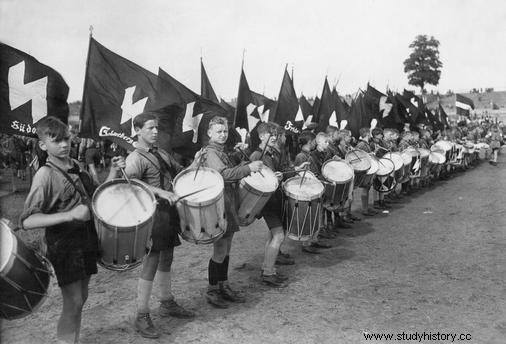
The Hitler Youth was open to any young person in the country, male or female, although it was focused on males. The only conditions to be able to enter were two:to be Aryan and to commune with the Nazi ideals. The organization focused its search for new members among the impoverished lower classes. By giving the boys a uniform, all the members were the same, since the difference in class could not be appreciated. This instilled in them a very strong and satisfying feeling of belonging to the group.
The members of the Hitler Youth collaborated with the SA in party propaganda. Dressed in their brown uniforms, they roamed the cities and towns putting up signs as the election approached. But it was also a playful group. The Hitler Youth organized outdoor activities and camps so that these children of poor workers could enjoy a little leisure.
The role of the Hitler Youth in Nazi Germany
Despite being an important workforce during the 1920s, helping in all kinds of Nazi party activities, Hitler himself was not convinced of the usefulness of this organization. After all, they were too young to vote.
This perception changed in 1932, months before Hitler came to power. On March 21 of that year, Potsdam Day was celebrated as in the previous ones. The former city of residence for the Prussian kings and German emperors was a leading center of German nationalism. The remains of Frederick William I and his son, Frederick II the Great, were laid to rest in the Potsdam Garrison Church. In a military, aristocratic and bourgeois environment, each year tribute was paid to these characters in a markedly nationalist exaltation celebration.
That same day the Hitler Youth organized a great parade with more than 70,000 of its members. Martialism, order and above all devotion to the Führer they changed Hitler's mind about the role the organization would play in his regime. The Hitler Youth was the perfect body to train the future generations of Nazi Germany. In 1933 there were 9 million young people in Germany. The Hitler Youth would be his springboard into Nazi ideology.
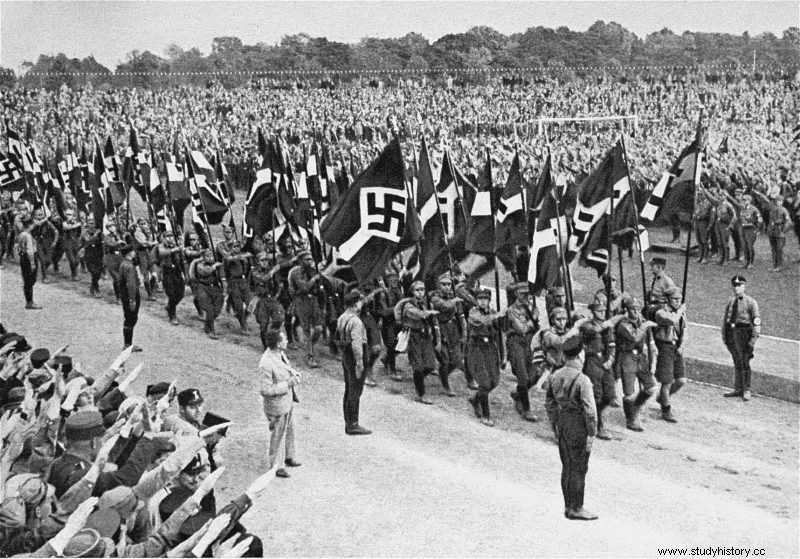
Hitler Youth since 1933
Although by January 1933, when the Nazi party came to power, the Hitler Youth were an important movement with around 100,000 members, this figure was only a shadow of what it would become during the 12 years of Germany. Nazi.
In 1933 all political parties in Germany were dissolved except for the Nazi party. The youth movements of these organizations were banned and their members were forced to join the Hitler Youth. But not only force attracted youth to the organization.
One of the most anticipated activities by young people at that time were the summer camps that all kinds of associations organized for their young people. The most important in number were those organized by the different Christian denominations in the country. Since 1933, the Hitler Youth had a monopoly on this type of camp, which made it necessary to belong to the organization if one wanted to enjoy this type of activity.
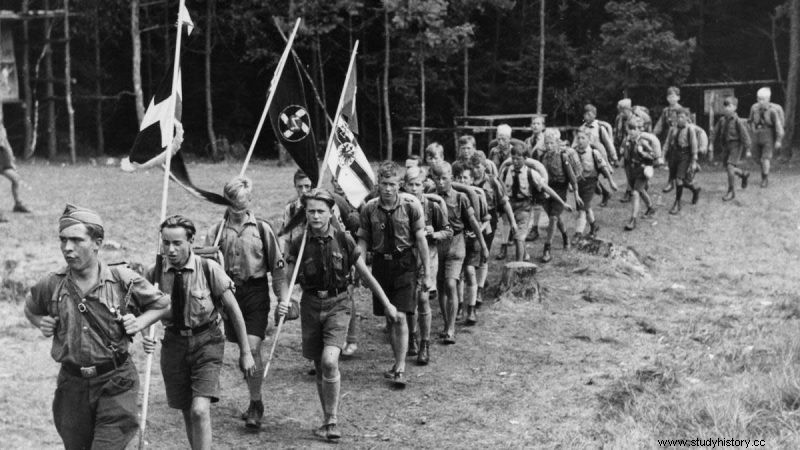
Thanks to government support, the organization grew to 2,000,000 members in just twelve months. As long as you weren't a Jew or a political opponent, life in Nazi Germany could be quite pleasant.
The importance of the Hitler Youth was such that the organization had a ministry dedicated to them. The ministry had two different men in charge. Between 1933 and 1940 it was directed by Baldur von Schirach and between 1941 and 1945 by Artur Axmann.
Despite their prominence during the early years of the Hitler Youth regime, some religious youth organizations survived until 1937. In that year they were dissolved and membership in the Hitler Youth became compulsory.
The training within the Hitler Youth
The organization was intended to mentor young people, instilling in them the National Socialist ideal, turning them into Nazi fanatics, and training them as soldiers for future Nazi Germany wars.
Everything was disguised as games, but in reality they hid a very strong and strict indoctrination and an elite physical preparation. The members of the Hitler Youth participated in different activities that simulated combat. They carried out marches of up to 20 kilometers and simulated war actions.
War games were regulated. Different groups of boys of different ages were created. They were given only a map and a compass and the combat area was marked out. In a certain time they had to find the other groups and fight with them to snatch the bracelets that each member wore. That bracelet was later presented in the camp as a trophy. The weak and puny were ridiculed by the rest of the platoon.
They were also taught to obey blindly. Periodically parades were organized for its members, so that they learned to follow the steps and the orders in a festive and recognition atmosphere.
From certain ages activities related to the three branches of the army were organized. The most popular was the one intended for future Luftwaffe pilots. . With large unpowered gliders young people could learn to fly. For German teenagers, that was an incredible activity.
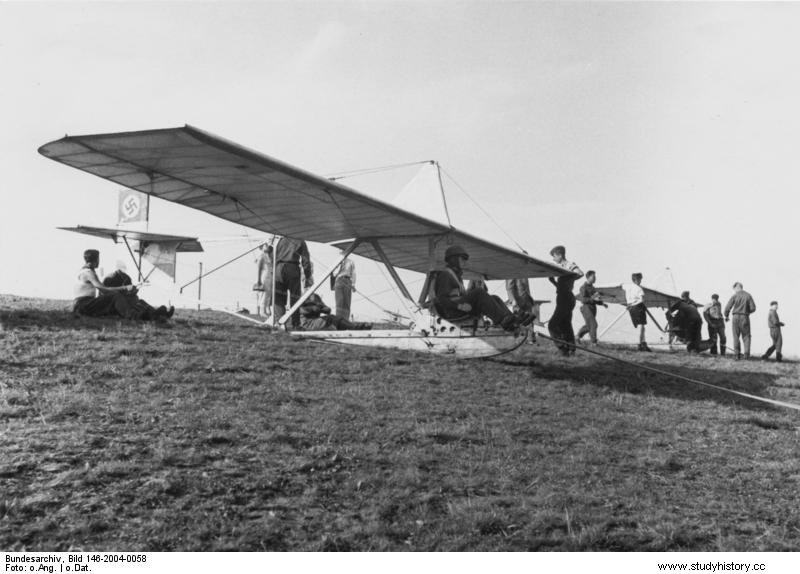
The Hitler Youth during the war
On many occasions the young men of the Hitler Youth were the only males left in a town. The adults had entered the armed forces or been assigned to factories to produce weapons and war machines.
His role was therefore key within the regime in times of war. At first, they were in charge of support aid for the civilian population. They helped in the fires after the bombings and worked in different jobs where the workforce was lacking.
On February 15, 1943, the Hitler Youth finally entered the fray. The first destination of 200,000 of these young people was the anti-aircraft artillery. German cities were attacked daily by Allied bombers. The men of fighting age were at the front, so the young men had to defend the homeland at the head of these units. Thousands of young people from Germany passed through them, including the writer Günter Grass and Joseph Ratzinger, who would become Pope Benedict XVI.
Finally in 1944 combat units of the Hitler Youth began to be organized. The unit most famous for its action on the front lines and for its war crimes was the 12th SS Panzer Division, led by Brigadier General Kurt Meyer. The division earned the respect of its enemies outside Caen when it managed to halt the British and Canadian advance. She was also responsible for the murder of dozens of Allied prisoners of war.
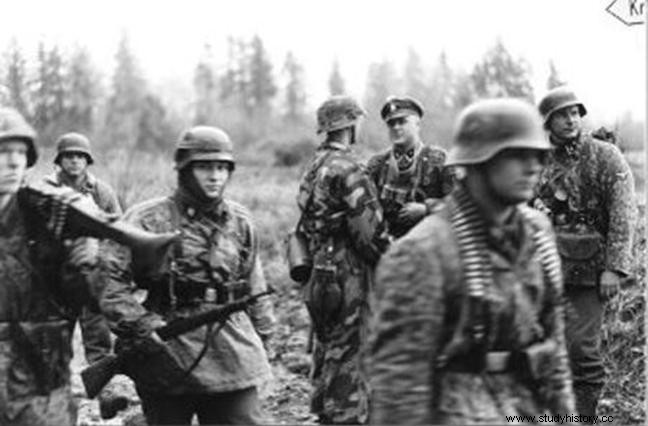
The last battle of the Hitler Youth was the defense of Berlin. Of the 700,000 German fighters in the capital there were barely 30,000 soldiers. The rest were elders of the Volkstrum , the popular militia, and children and adolescents of the Hitler Youth. Armed with machine guns and anti-tank weapons, they tried to stop the powerful red army without success.
After the war, the organization was banned. To re-educate these fanaticized youth, the occupying countries had to create new youth organizations for denazification. Today only some of its members are still alive and are a testimony of that time.
